Private Jacob Newcomber Kiehl
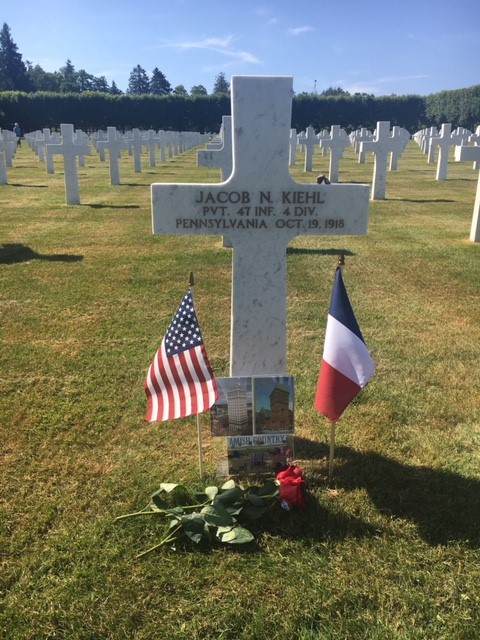
- Unit: 47th Infantry, 4th Division, G Company
- Service Number: 452962
- Date of Birth: August 28, 1891
- Entered the Military: May 14, 1918
- Date of Death: October 19, 1918
- Hometown: Lancaster, Pennsylvania
- Place of Death: near Serencourt, France
- Cemetery: Plot A, Row 11, Grave 21. Meuse-Argonne American Cemetery, Romagne-Sous-Montfaucon, France
J.P. McCaskey High School Campus
2017-2018
Early Life
U.S. Army Private Jacob Newcomber Kiehl was born on November 28, 1891, in Lancaster, Pennsylvania. His father, Jacob, was an engineer and firefighter and his mother, Mary, stayed home to raise seven children: Elmer, Benjamin, Mary, Jacob, Wesley, Ephraim and Ella. During his childhood, Jacob lived in rural Lancaster- a bucolic setting where he likely passed a simple life filled with hard work and family.
Eventually Jacob and two of his brothers, Ephraim and Wesley, found work at Armstrong Flooring in the city. Jacob worked as a linoleum maker. Jacob, ever the dutiful son, contributed half of his paycheck every week to help support the family.
Military Experience
Enlistment
On May 14, 1918 at the age of 27, Jacob enlisted in the U.S. Army in Ephrata, Pennsylvania, along with his brother, Wesley. Jacob was 5’7” had blond hair and blue eyes, and was single when he became Private Kiehl. On May 16, 1918, two days after enlisting, Kiehl was sent to the Columbus Barracks in Ohio. After his training, on August 3, 1918, Kiehl boarded the USS Leviathan in route to Europe and the front with the 56th Infantry of the 7th Division. On August 11, 1918 Private Kiehl arrived in France.
Always Onto the Next Objective
Kiehl transferred to the 4th Division, 47th Infantry Regiment, G Company after a few weeks in France. With the 47th Infantry Regiment, Kiehl spent significant time on the western front. Private Kiehl’s job was to constantly advance to the next objective. The general orders of the 47th Infantry Regiment were to “attack the hostile positions between the Rau des Forges and the Epis de Fôret, exploit its successes by advancing northward from the Bois de Fôret and organize the defense for the western banks of the Meuse between Brieulles-sur Meuse and Sassey-sur-Meuse.” With this objective in mind, Kiehl and his unit spent the better part of three weeks on the front lines, engaging in combat with rifle and bayonet. Kiehl and the 47th Infantry Regiment saw action in the Aisne-Marne, St. Mihiel, and Meuse Argonne campaigns.
Meuse-Argonne
In the Meuse-Argonne campaign, the 47th Infantry Regiment and Kiehl were ordered to “push the attack vigorously.” On the morning of September 26, 1918, Kiehl was part of the “most terrific barrage of the war.” The American barrage against the enemy lasted for hours and poured a destructive fire on the enemy front. It was said to be the most rapidly advancing barrage known in the war to that point. The 47th Infantry Regiment made its way north, supporting and fighting on the front line for several weeks. Then, on October 12, 1918, the Germans threw upwards of 1,000 shells in the area of the Bois de Fôret. The Americans responded in kind, but the enemy still managed to launch over twice as many shells as the Americans over the next few days. It was here in the Bois de Fôret on October 13, 1918 that Kiehl was exposed to gas.
Gassed
Private Kiehl was transferred to Field Hospital number 132 and then to Evacuation Hospital 8. Private Kiehl died of gas exposure on October 19, 1918, after six days in the hospital and only a few weeks away from the end of the fighting.

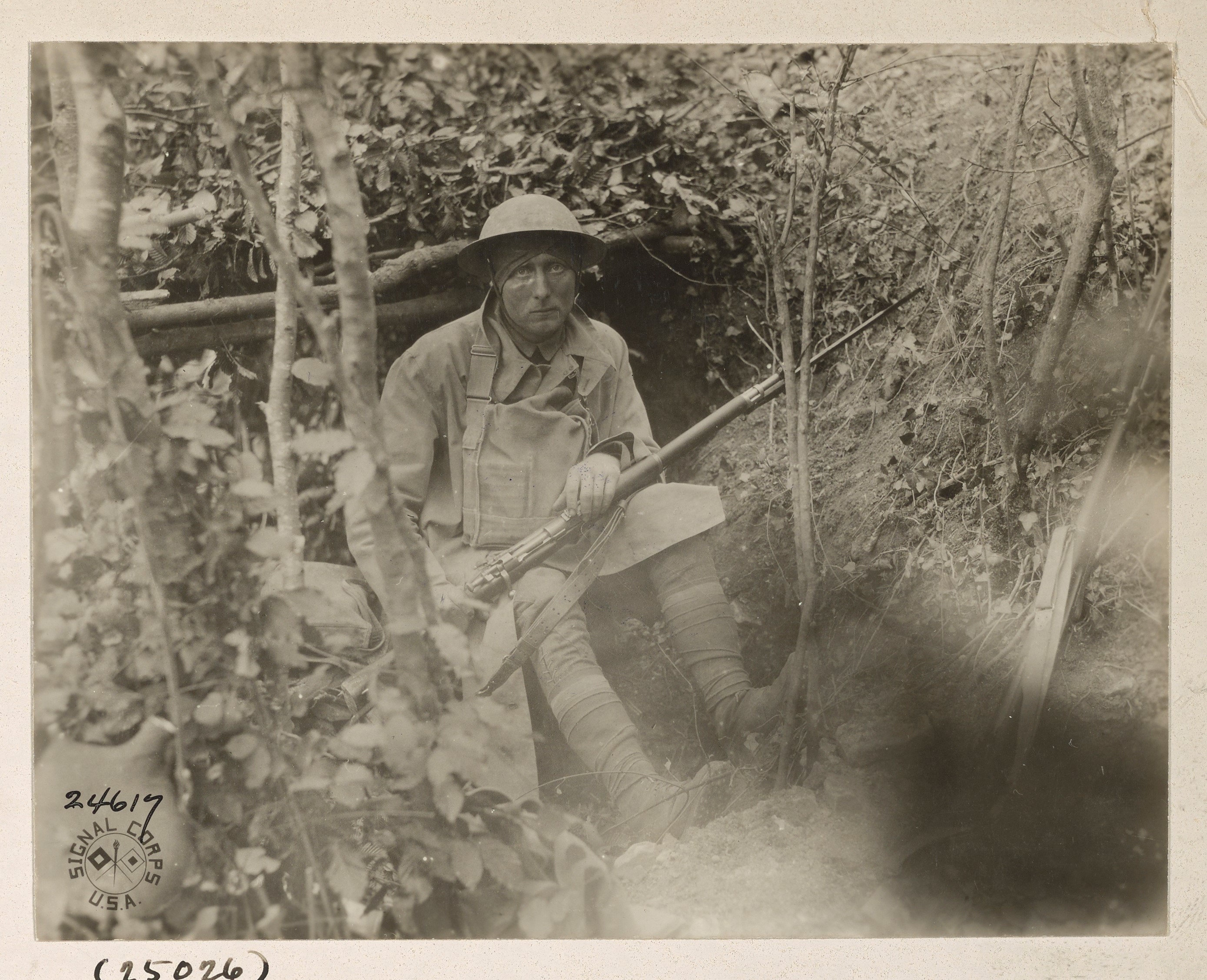
Corporal Erland Johnson in a trench near the town of Bois de la Cote Lamont, France, November 3, 1918. National Archives and Records Administration (111-SC-24617-ac).
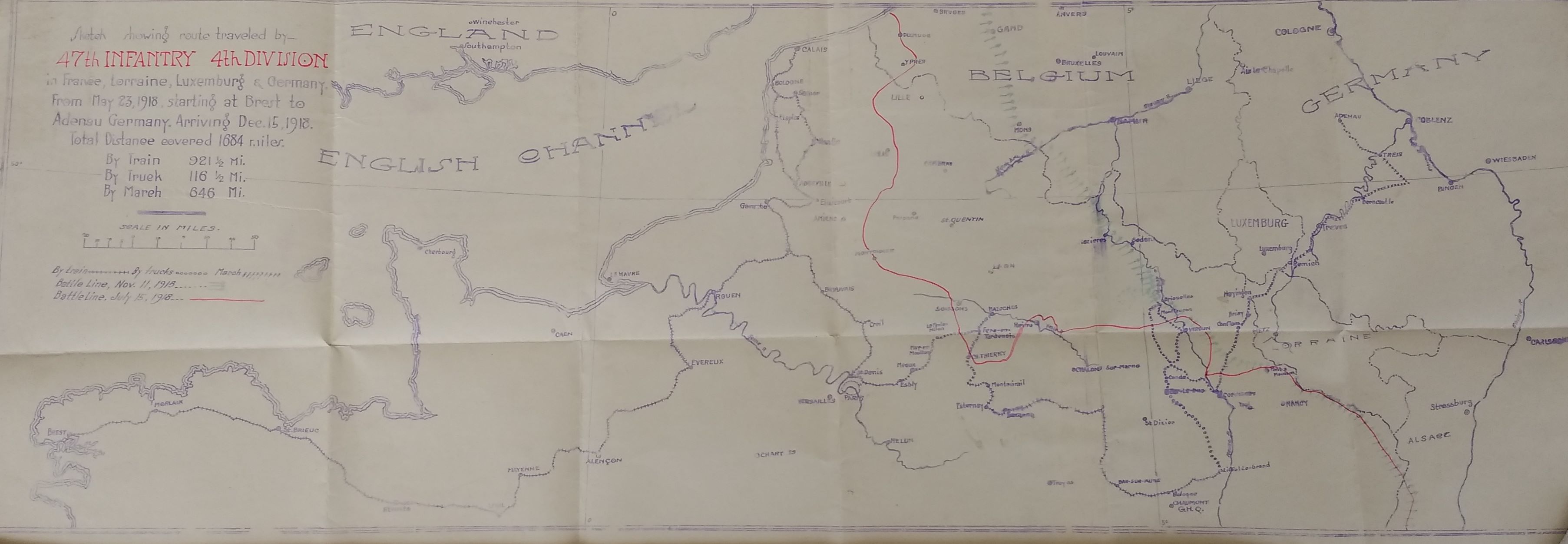
Eulogy
Commemoration
Jacob Kiehl’s body was interred in a temporary American cemetery near Serencourt, France. His remains were marked by a cross and his dog tags. His father chose to bury his son in France. Jacob’s remains were transferred to Meuse-Argonne American Cemetery where he rests permanently today. In Lancaster, his mother, Mary, unveiled a Doughboy statue dedicated to World War I soldiers from the 7th Ward in Lancaster.
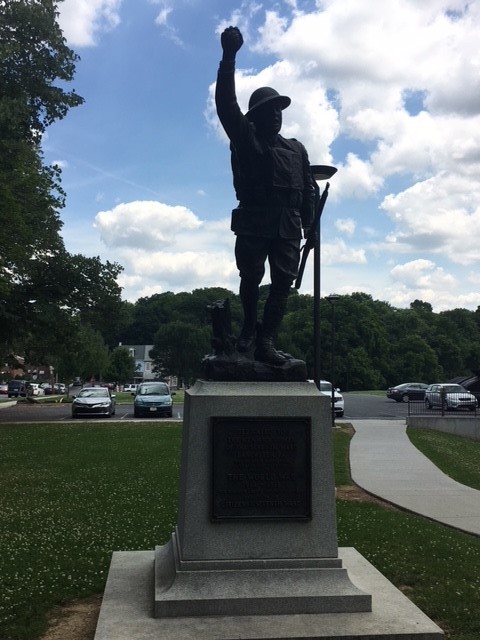
Doughboy statue honoring soldiers from Lancaster, Pennsylvania, June 26, 2018. Courtesy of Alison Browning.
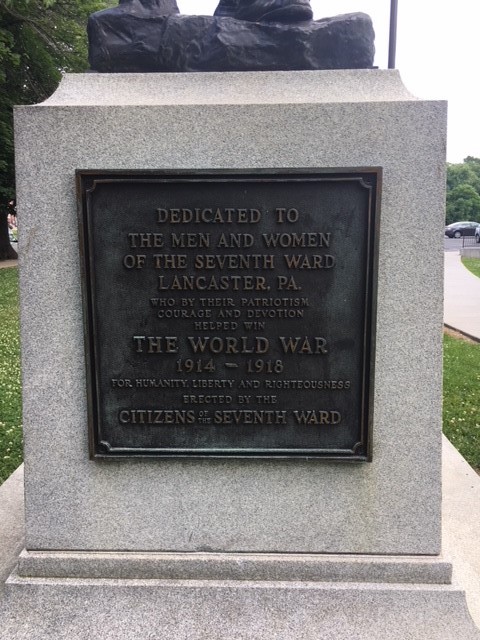
Inscription on the doughboy statue honoring soldiers from Lancaster, Pennsylvania, June 26, 2018. Courtesy of Alison Browning.
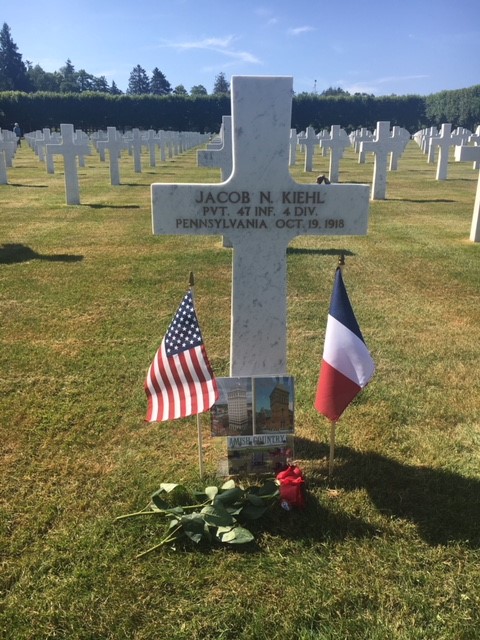
Grave marker of Private Jacob N. Kiehl at Meuse-Argonne Cemetery in Romagne-Sous-Montfaucon, Francee, July 4, 2018. Courtesy of Alison Browning.
Reflection
Bibliography
4th Division; Records of the American Expeditionary Forces (World War I), Records of Combat Divisions, 1917-1919, Record Group 120 (Boxes 32-33); National Archives at College Park, College Park, MD.
39th Division; Records of the American Expeditionary Forces (World War I), Records of Combat Divisions, 1918-1919, Record Group 120 (Box 49); National Archives at College Park, College Park, MD.
Dunn, C.E. Corporal in trench. Photograph. October 2, 1918. National Archives and Records Administration (111-SC-24617-ac). Image.
Dunn, C.E. American Advance in the Argonne Region. September 1, 1918. National Archives and Records Administration (111-SC-23130-ac). Image.
Jacob N. Kiehl. Veteran’s Compensation Application, 1918, PA Historical and Museum Commission. Digital Images. ancestry.com.
Jacob N. Kiehl World War I Burial Case File; Correspondence, Reports, Telegrams, Applications and Other Papers relating to Burials of Service Personnel, Records of the Quartermaster General’s Office, 1915-1935, Record Group 92; National Archives and Records Administration – St. Louis.
Melega, Bill. “Looking at the Meuse-Argonne.” American Battle Monuments Commission. Accessed April 30,2018. www.abmc.gov/learning-resources/lesson-plans/looking-meuse-argonne.
Pennsylvania. Lancaster County. 1900 U.S. Census. Digital Image. ancestry.com.
Pennsylvania. Lancaster County. 1910 U.S. Census. Digital Image. ancestry.com.
Pennsylvania. Lancaster County. 1920 U.S. Census. Digital Image. ancestry.com.
Signal Corps, U.S.A. In the captured salient of St. Miehl. Photograph. November 5, 1918. National Archives and Records Administration (111-SC-25031-ac). Image.

